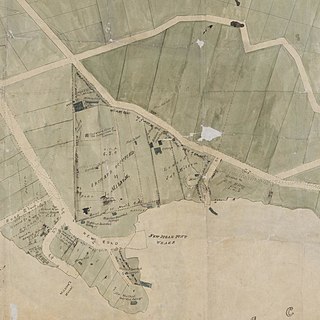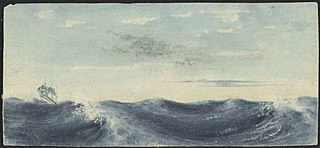Related Research Articles
Bengalee was a three-masted merchant barque built in 1837 at Dumbarton. She first appeared in Lloyd's Register (LR) in 1838 with Hamlin, master, Hamlin and Company, of Greenock, owners, and trade Clyde–Calcutta. Captain Thomas Hamlin did not allow the consumption of alcohol on his ship, thus it was known as a temperance ship.
Simon Taylor was a barque built in 1824 on the River Thames that transported assisted migrants to Western Australia.

Klemzig is a suburb of Adelaide in the City of Port Adelaide Enfield. It was the first settlement of German immigrants in Australia and was named after the village of Klemzig in what was then German Prussia and is now Klępsk in western Poland.

Fortitude was a barque launched at Scarborough in 1842. In the 1840s she brought free settlers to the colonies of South Australia and Queensland. Thereafter she sailed to India and China, and made one more voyage carrying female immigrants to Port Phillip. She was wrecked circa 1866.

Surry, also known as Surrey, was a square-rigged transport ship, which had an especially long career transporting convicts to Australia. In 11 voyages, the most of any convict transport, she brought 2,177 convicts, male and female, and so became one of the best-known of the vessels that visited Australia. In all, she lost 51 men and one woman during her various passages, 46 of the men dying during her first and most notorious voyage in 1814 when she was under the command of James Patterson. The high death toll on her first voyage led to a Board of Enquiry, which blamed neglect by the Master and Surgeon.
John Barry was a three-masted merchant ship, convict transport, and immigrant transport built in 1814 at Whitby, England by John Barry for his own interests. A typhoon damaged her in 1841 and at last report she was an opium hulk at Hong Kong.
Roslin Castle was a barque of 450 tons built in 1819 at Bristol. She was a merchant ship that also made five voyages transporting convicts to Australia. Described as a single decker, her hull was sheathed in copper in 1823 and was sheathed in patent felt and copper over-boards in 1828. She later served as a whaling vessel out of Sydney, Australia.
Somersetshire, was launched in 1810 on the River Thames as a West Indiaman. She made two voyages to Australia transporting convicts, and one in between with passengers. On the second convict transport voyage some convicts and guards planned a mutiny that her captain was able to foil. Somersetshire is last listed in 1844.
Coromandel was a sailing ship built at Quebec in 1834. She was owned by Ridgeway and her home port was Glasgow. She was the first ship to bring settlers to South Australia after it was proclaimed a colony in 1836 and one of the early ships bringing New Zealand Company settlers to Wellington, New Zealand in 1840.
Blenheim was built in 1834 at Jarrow, England. She made three voyages transporting convicts to Australia. She also carried emigrants to New Zealand. She otherwise carried ordinary valuable cargo and in one of such voyages came across what has since been named Blenheim Reef, in the Indian Ocean. She disappeared without a trace, presumed foundered, after August 1846.
Numerous vessels have borne the name Coromandel, named for the Coromandel Coast.
Katherine Stewart Forbes was a full-rigged ship built by William & Henry Pitcher at Northfleet dockyard in Kent, England in 1818. She was classified as "A1", a first class vessel made from first quality materials. The ship was launched for A. Chapman and Company and named by Katherine Stewart, the daughter of Charles Forbes MP in 1818, on 31 October or 5 November. She was re-rigged as a barque about 1836.
Whitby was a three-masted, square-rigger launched in 1837 and later re-rigged as a barque. She was registered in London, and made voyages to India, British Guiana, Australia, and New Zealand. In 1841 Whitby, Arrow, and Will Watch carried surveyors and labourers for the New Zealand Company to prepare plots for the first settlers. Whitby was wrecked at Kaipara Harbour in April 1853.
David Clark was launched in 1816 and may have been broken up at Batavia in 1854. She sailed one of the last voyages under charter to the British East India Company (EIC). In 1839 she carried mainly Scots assisted migrants to Australia, and was the first immigrant ship to sail from Great Britain directly to Port Phillip. In 1842 she transported more than 300 convicts to Hobart. She was last listed in Lloyd's Register in 1854.
Royal Admiral was a 414-ton timber three-masted barque, built at King's Lynn, England in 1828 and used as a merchant ship. Royal Admiral first served for trade to India. She subsequently sailed to Australia on four occasions carrying convicts, from Portsmouth to Port Jackson in 1830, from Dublin to Port Jackson in 1833 and 1834, and from Woolwich to Hobart Town in 1842.
Elizabeth was a merchant ship built at Singapore, British India in 1830. She made one voyage transporting convicts from the Swan River Colony to Sydney, Australia. She wrecked in 1839.
The barque Maria was launched at Yarmouth in 1836. Maria was originally used on the England to Bombay run in the 1830s. She sank with the loss of 28 lives on 23 July 1851 near Cape Terawhiti on the North Island of New Zealand. Only two crew members survived.
Hooghly was a full-rigged merchant ship built on the Thames, England, and launched in 1819. She made two voyages under charter to the British East India Company (EIC), four voyages transporting convicts from England and Ireland to Australia, as well as voyages transporting emigrants to South Australia between 1839 and 1856. Around 1858 she was re-rigged as a barque. She sank off Algiers in 1863.

The New Zealand Company was a 19th-century English company that played a key role in the colonisation of New Zealand. The company was formed to carry out the principles of systematic colonisation devised by Edward Gibbon Wakefield, who envisaged the creation of a new-model English society in the southern hemisphere. Under Wakefield's model, the colony would attract capitalists who would then have a ready supply of labour—migrant labourers who could not initially afford to be property owners, but who would have the expectation of one day buying land with their savings.

Africaine was a barque launched in 1831 at Jarrow on the River Tyne in England. In 1836 she carried immigrants as part of the First Fleet of South Australia. She was wrecked on 23 September 1843.
References
- 1 2 "Details for the ship Thomas Harrison (1836)". Claim a convict. Retrieved 19 July 2019.
- ↑ "Assisted immigrant ships 1832–1889". Libraries of Tasmania. Retrieved 19 July 2019.
- 1 2 3 4 5 6 "Thomas Harrison". Passengers in History. 21 January 2016. Retrieved 19 July 2019.
- ↑ "Shipping intelligence: Arrivals". The Australian . Vol. IV, no. 304. New South Wales, Australia. 10 June 1836. p. 2. Retrieved 19 July 2019– via National Library of Australia.
- 1 2 "Convict Ship Thomas Harrison 1836". Jenwilletts.com. Retrieved 19 July 2019.
- ↑ "South Australian shipping". Perthdps: Passenger ships arriving in Australasian ports. Retrieved 19 July 2019.
...compiled from Ronald Parson's 1988 edition of Migrant Ships for South Australia 1836–1860.
- ↑ "Thomas Harrison 1839" . Retrieved 19 July 2019.
- ↑ "Thomas Harrison". Early Settlers Database. Nelson Provincial Museum. Retrieved 19 July 2019.
- ↑ Malone, C. B. "Hocton, Appo". Dictionary of New Zealand Biography . Ministry for Culture and Heritage . Retrieved 25 October 2022.
- ↑ Miller, Graham M. "Deans, John and Deans, William". Dictionary of New Zealand Biography . Ministry for Culture and Heritage . Retrieved 25 October 2022.
- ↑ Scholefield, Guy, ed. (1940). A Dictionary of New Zealand Biography: A–L (PDF). Vol. I. Wellington: Department of Internal Affairs. p. 498. Retrieved 25 October 2022.